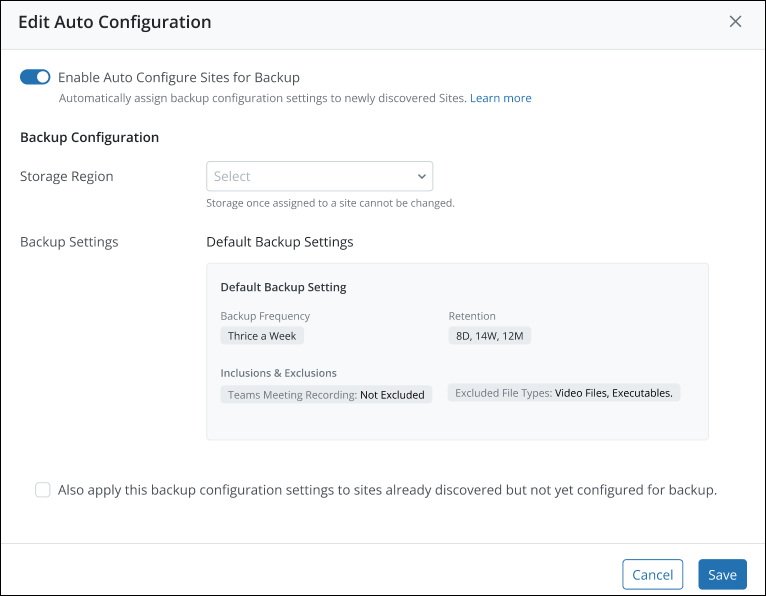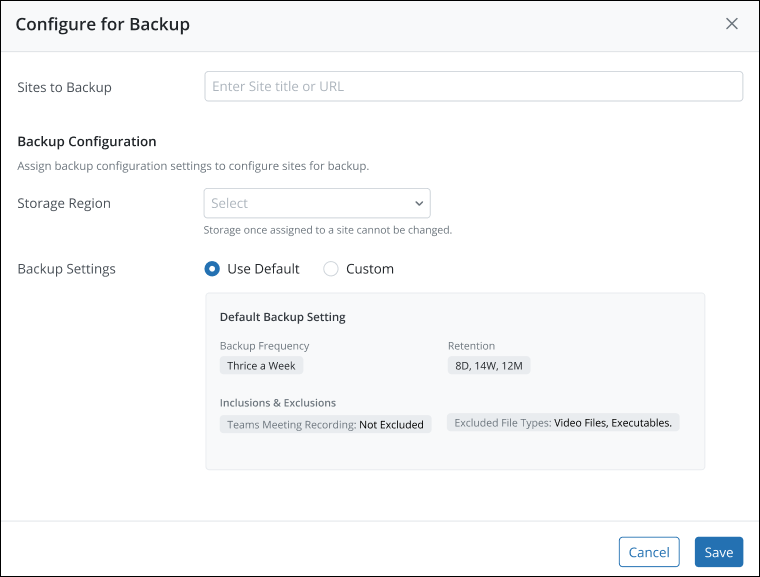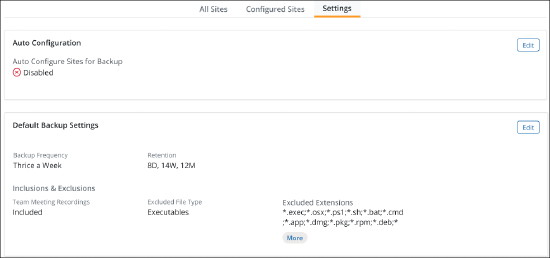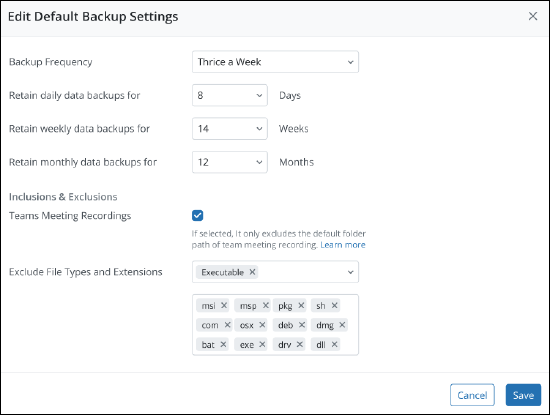Configure inSync to protect SharePoint Online
Before you begin
Before you initiate inSync configuration to protect SharePoint Online data, ensure that you have the following accounts created.
- Microsoft 365 global administrator account with a valid Microsoft 365 license.
Configure inSync to protect SharePoint Online
Log into inSync Management Console as a inSync Cloud administrator and perform the following steps to set-up inSync to protect SharePoint Online.
Step 1: Provide inSync permissions to access SharePoint Online data
To begin with SharePoint Online data backup, you need to authorize inSync with SharePoint Online app data access. For procedure with screenshots, see Configure Druva inSync for Microsoft 365.
Once you initiate app configuration from the inSync Management Console, the application redirects you to the Microsoft 365 login page. Log in as a Global Administrator to review the requested app permissions and grant access to the app data. To know more about the requested permissions and their purpose, check the Microsoft 365 App Permissions for Druva App article.
inSync communicates with Microsoft 365 services using OAuth 2.0, an open protocol for token-based authentication and authorization. For more information, see the OAuth website.
Support for Azure Active Directory (AD) Conditional Access policies
If your organization uses Azure AD Conditional Access policies for authenticating and providing conditional access to users, the app configuration step will adhere to these policies. For more information, see Support for Azure Active_Directory (AD) Conditional Access policies.
After you complete the configuration of inSync with Microsoft 365 app, you can use the Verify Configuration option to check if inSync can access your users. For information about verifying configuration, see Configure Druva inSync for Microsoft 365.
Step 2: Get data encryption key (ekey)
To ensure that the Microsoft 365 data that is backed up is secure, you must configure inSync to get the data encryption key (ekey). For information about configuring inSync to get the data encryption key, see Configure Druva inSync for Microsoft 365.
Step 3: Configure SharePoint for backup and restore
The settings that you define automatically apply to all subsequent auto-discovered sites. You can also change the settings of any auto-discovered site.
You can configure SharePoint sites for backup and restore in the following ways:
Auto Configuration of SharePoint sites
Use this method to automatically detect any new sites and to apply the global or same backup schedule to each of the newly discovered and configured sites.
- Sign in to Druva Cloud Platform Console and navigate to Microsoft 365 > SharePoint.
A page that lists all the discovered sites appears. The status of all the discovered sites by default is set as Not Configured.
Note: To search the sites by Title or URL, enter the required information in the search box and press Enter. - Go to the Settings tab. From the Auto Configuration section, click Edit.

-
The Edit Auto Configuration popup is displayed.

-
Turn on the Enable Auto Configure Sites for Backup option if you want to automatically assign backup configuration settings to newly discovered sites.
-
The Edit Auto Configuration window is displayed.

-
Select the storage to be assigned to the discovered sites.
Note: The default backup settings from the profile will be applied. -
Select the checkbox if you want to apply these backup configuration settings to sites already discovered but not yet configured for backup.
-
Click Save.
Custom configuration of SharePoint sites for backup
Perform the following steps to assign backup configuration settings to configure Teams and its associated apps.
- Sign in to Druva Cloud Platform Console and navigate to Microsoft 365 > SharePoint.
A page that lists all the discovered sites appears. -
Select one or more sites and click Configure for Backup.

-
Enter the title or URL of the site to be backed up.
-
Select the storage region. Storage once assigned cannot be changed.
-
Use either default or custom backup settings.
-
Default backup settings - Default settings are already defined in the profile. To edit the default backup settings, see Edit default backup settings.
-
Custom backup settings -
-
Backup Frequency - Select the frequency of backups for Teams. For scheduled backups, at least one AD Connector should be registered and connected to inSync Cloud. For more information see Prerequisites to back up SaaS Apps data.
-
Retain daily data backups for - Type the number of days that you want to retain all backups.
At the end of the backup period, inSync will delete the data from the storage.
For example, if you specify that you want to retain all backups for 5 days and inSync completed the backup operation on January 6, 2023, inSync will delete the backup data from the storage on January 11, 2023.
-
Data Lock - Enables the Data Lock feature. For more information, see Data Lock.
Note: Only Cloud Administrators can enable the Data Lock feature.
To enable the Data Lock feature, select the Enable Data Lock checkbox and on the confirmation window, click Yes. On the summary page, the Data Lock status is displayed as enabled. These details will be captured in the Admin Audit Trail for auditing purposes.
Note: Once you enable the Data Lock feature, you cannot:
- Delete the snapshots.
- Edit the retention period.
- Disable the Data Lock setting.
- Go back to default settings.
- Teams Meeting Recordings - The backups will exclude all files from the default folder path of Teams Meeting Recordings (TMR) by default. This setting applies to Teams sites only.
The default folder path is /Channel name/Documents/Recordings.
If you want to back up TMR files, enable this setting.
Important:
-
The first backup after disabling the exclusion setting will be a full scan backup.
-
To avoid a full scan backup of all configured sites, disable the exclusion setting only for those sites where you have a requirement to back up TMR files.
For more information, see Exclusion of Teams Meeting Recordings from backups.
-
- Exclude File Types and Extensions - Type the file types that you want to exclude from the backup of a SharePoint site collection. The file extensions are automatically added to the adjacent field. If you want to remove a file type, click the file type.
- Relative URL Paths - Specify the relative URL path of a subsite, Document Library, or List separated by a semicolon to exclude the specified paths from SharePoint backup.
-
-
-
Click Save.
Relative URL Paths
Use the Relative URL Paths option within inSync Management Console to exclude any specific subsites, Document Libraries, List or Folder nested under a subsite from getting backed up and thus reduce the time required for SharePoint sites data backup.
SharePoint has a unique URL for each subsite, Document Library, and List. You can copy the Relative URL Path from the complete URL.
Each URL of the site content has a common part within the link as mentioned in the example below. Relative URL Path is what remains when you remove the common part from the URL.
-
URL starts with root site URL: For example, https://contoso.sharepoint.com/sites/DruvaUniversity/
- URL ends with /Forms/AllItems.aspx or AllItems.aspx
Note:
- For List , the relative URL path contains the List string.
- URL has %20 string to represent the ' ' one space character. You can directly copy-paste the relative URL from the browser with %20 in it. Alternatively, you can manually provide the relative URL without %20. For example, InSync%20Course%20Documents or InSync Course Documents
Examples of Relative URL Paths for different site contents:
| Site Content Type | Title displayed on SharePoint | Complete URL | Relative URL |
|---|---|---|---|
| Root Site | Druva University |
https://contoso.sharepoint.com/sites/DruvaUniversity |
Not Applicable |
| Document Library at root site level | inSync Course Documents | https://contoso.sharepoint.com/sites.../AllItems.aspx |
InSync%20Course%20Documents |
| List at root site level | inSync PM List | https://contoso.sharepoint.com/sites.../AllItems.aspx |
Lists/InSync%20PM%20List |
| Subsite | InSync Phoenix Subsite | https://contoso.sharepoint.com/sites...enixAppSubsite | inSyncPhoenixAppSubsite |
| Document Library at Subsite | SaaS Apps Product Documents | https://contoso.sharepoint.com/sites.../AllItems.aspx |
inSyncCloudAppSubsite/CloudApp%20Product%20Documents |
| List at Subsite | Cloud App Developer List | https://contoso.sharepoint.com/sites.../AllItems.aspx | inSyncCloudAppSubsite/Lists/CloudApp%20Developer%20LIst OR inSyncCloudAppSubsite/Lists/CloudApp Developer LIst |
| Subsite at the Subsite level | Salesforce Subsite | https://contoso.sharepoint.com/sites...orce%20Subsite | inSyncCloudAppSubsite/Sales%20Force%20Subsite OR inSyncCloudAppSubsite/Sales Force Subsite |
Edit default backup settings
Edit the default backup settings to change the backup and retention settings from the default profile. To do that:
- Go to the Settings tab.
- From the Default Backup Settings section, click Edit.

The Edit Default Backup Settings window is displayed.

-
Select the frequency of backups. By default, it is once a day. You can change it to Twice a Day, Thrice a Week, Twice a Week, or Once a Week. For more information, see Define backup interval for SaaS Apps.
-
In the Retain daily data backup for fields, specify the number of days, weeks, or months for which you want to retain all backups. At the end of the backup period, inSync will delete the data from the storage. For example, suppose you specify that you want to retain all backups for five days and inSync completed the backup operation on January 6, 2022. In that case, inSync will delete the backup data from the storage on January 11, 2022.
Note: To retain the backups for an unlimited period, enter 0 as the value for all daily, weekly, and monthly retention settings. -
Select the Teams Meetings Recordings checkbox to exclude the default folder path of Teams Meeting Recordings (TMR) from the backup.
-
In the Exclude File Types and Extensions field, specify the file types that you want to exclude from the backup of a SharePoint site collection. The file extensions are automatically added to the adjacent field. If you want to remove a file type, click the file type.
-
Click Save.

